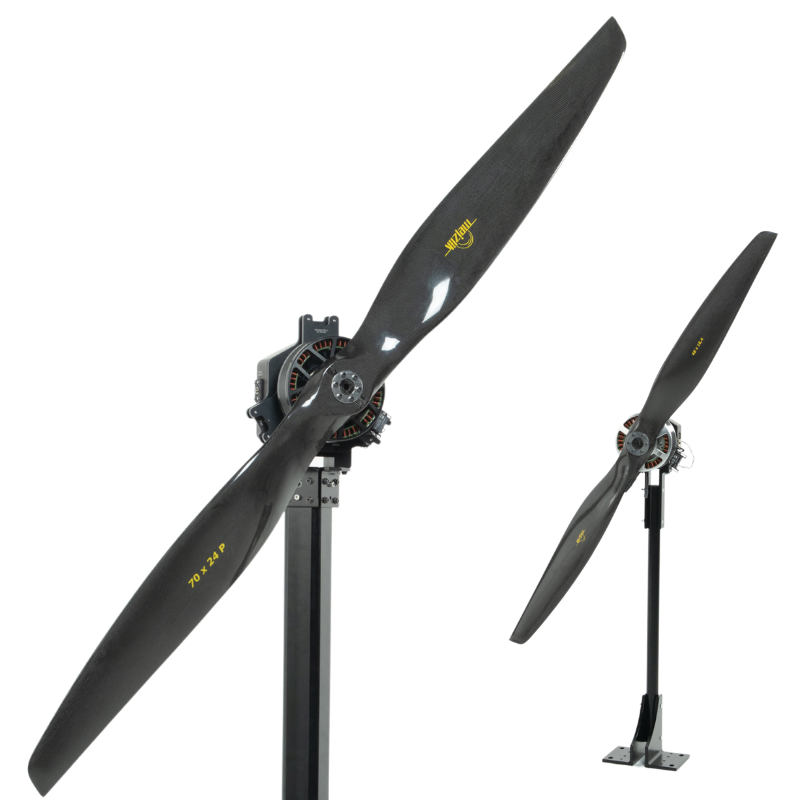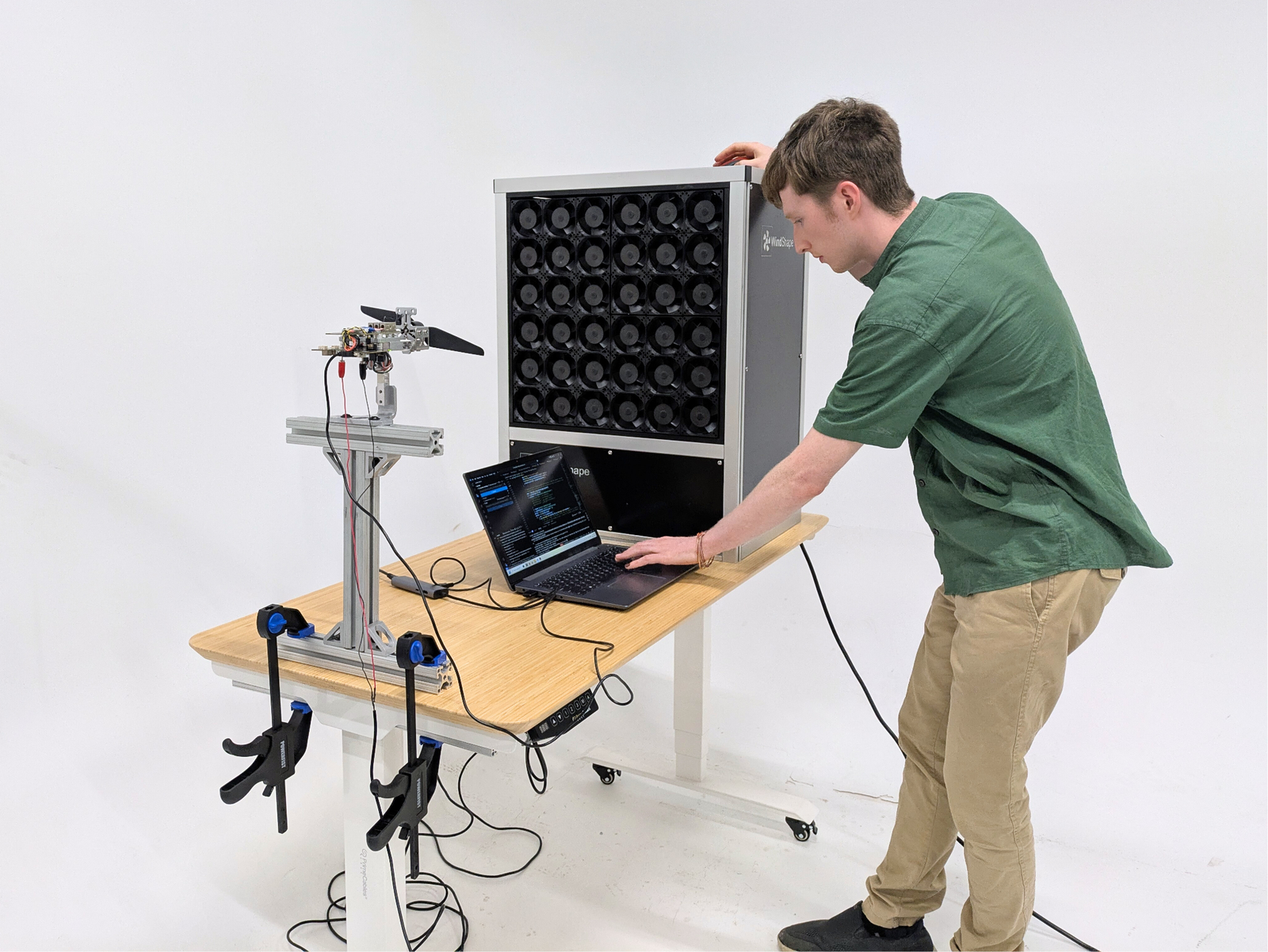Video Tutorial
Testing your motors and propellers is the most effective way to evaluate performance and find areas for improvement in your design.
It allows you to make improvements in efficiency, which translates directly into increases in endurance, flight time, payload capacity, and more.
In this article we will cover both the how and the why of motor and propeller testing.
Table of Contents
- Why Test Your Motors and Propellers
- What Parameters Should I Measure?
- Brushless motor efficiency
- Propeller efficiency
- Overall system efficiency
- How to Test Motors and Propellers with a Thrust Stand
- Test Procedure for Static Tests
- How to Use the Efficiency Results
Why Test Your Motors and Propellers
You must first ask yourself, what are your, or your end user’s needs? This question is important as it will help you know which parameters to optimize.
- Do you want to fly longer to film uninterrupted for longer periods?
- Do you want to carry a larger payload?
- Do you need more thrust and power to go faster, or to improve handling in strong winds?
- Do you have overheating problems and your application requires you to minimize failure rate?
The final choice of power system depends not only on the airframe and payload, but also on your application.
What Parameters Should I Measure?
Brushless Motor Efficiency

Figure 1: NTM propdrive 35-30 brushless motor and Quantum 13-4 carbon fiber prop.
To fully characterize a motor and determine its efficiency, you need to measure the following parameters.
- Voltage (V)
- Current (A)
- Throttle input (%)
- Motor load or torque (Nm)
- Speed (RPM)
The parameters listed above are important because they allow you to determine the following key performance indicators:
- Mechanical power (Watts) = Torque (Nm) * Speed (rad/s)
- Electrical power (Watts) = Voltage (V) * Current (A)
- Motor Efficiency = Mechanical power / Electrical power
The output speed is a function of the throttle, in %, and of the load or torque, in Nm. If you want to completely characterize a motor, you will need to test it with multiple input voltages and different loads. The throttle is changed with the controller, and the load is changed with the type and size of propeller.
Further reading: How Brushless Motors Work and How to Test Them
Propeller Efficiency
To find propeller efficiency, you will need to measure the following parameters:
- Speed (RPM)
- Torque (Nm)
- Thrust (g)
These parameters allow you to determine:
- Mechanical power (Watts) = Torque (Nm) * Speed (rad/s) ← same as the motor
- Propeller efficiency (g/watt) = Thrust (g) / Mechanical power (Watts)
Note that the mechanical power is the same for the motor and propeller. That is because all the motor’s mechanical power output goes into the propeller, since it is directly coupled to the motor’s shaft.
Overall System Efficiency
The overall efficiency of your system depends on how well your motor and propeller work together. Even with a motor and propeller that are highly efficient on their own, your system can be very inefficient if the two parts don’t match well.
Because these parts have a common link (the shaft), the overall system efficiency is expressed as:
System efficiency (g/watt) = Propeller efficiency (g/watt) * Motor Efficiency
where the system efficiency is in grams per watt of electrical power. Changing the motor, propeller, or even switching to another ESC will all contribute to changing the system efficiency.
Moreover, the efficiency value will only be valid for a specific command input and mechanical load. In practice, this means that you will need to test your motor over a range of command inputs and with various propellers (to vary the mechanical load) in order to get a full efficiency characterization.
How to Test Motors and Propellers with a Thrust Stand
In summary, to obtain motor and propeller efficiency you need to simultaneously record voltage, current, torque, thrust, and motor speed. By combining these readings you can extract the electrical and mechanical power, which in turn will give you the efficiency values.
The easiest and most effective way to perform these tests is with a thrust stand, a piece of equipment specifically designed for characterizing motors and propellers.
We used the Series 1585 thrust stand (5 kgf/ 2 Nm) to collect the data discussed below, but we also offer thrust stands measuring up to 500 kgf.
Further reading: Why You Should Test Your Drone's Motors and Propellers

Test Procedure for Static Tests
In this article we will only cover static tests (we won’t talk about dynamic tests involving angular acceleration, estimating stall torque, etc…).
Before starting your tests, we recommend to:
- Install your propeller in pusher configuration, to reduce ground effects with the motor mounting plate
- Have a reasonable distance between the propeller and other objects, again, to avoid ground effects
- Have all safety measures in place to protect the people in the room
- Configure your thrust stand to automatically cutoff the system should any parameter exceed its safe limit
A simple but effective test consists of ramping up the throttle in small steps, and recording a sample after every step. Before taking the sample at each step, allow the system to stabilize for a few seconds.
In the video at the beginning of the article, we demonstrate how we manually varied the throttle from 0 to 100% in 10 steps. This procedure could also have been performed using the RCbenchmark software’s automated test feature, which is covered in another tutorial.
Further reading: Automated Propulsion Test Scripts for Your Drone
The results obtained from our manual step test are shown in this CSV file.

How to Use the Efficiency Results
You can analyze your output data using any plotting software. Below is an example of a plot we generated obtained using the data from the CSV file linked above.
Here we have compared propeller thrust and mechanical efficiency, to see at what points our propulsion system operates most efficiently.

You could then compare this data with data from other tests using the same protocol but different propellers to find the one that is most efficient with your motor.
For more examples of the types of analysis that you can do with this data, check out our articles on motor and propeller testing.
Conclusion
- Series 1585 - measures up to 5 kgf of thrust / 2 Nm of torque
- Flight Stand 15 - measures up to 15 kgf of thrust / 8 Nm of torque
- Flight Stand 50 - measures up to 50 kgf of thrust / 30 Nm of torque
- Flight Stand 150 - measures up to 150 kgf of thrust / 150 Nm of torque
- Flight Stand 500 - measures up to 500 kgf of thrust / 1500 Nm of torque
Liked this tutorial or have questions? Let us know below.


 Back to Blog
Back to Blog


Lauren Nagel
November 27, 2023
Hi Daniel,
Great question. In this case the motor efficiency calculated is actually the motor + ESC efficiency. The system efficiency reflects the efficiency of the whole system including the motor, propeller, and ESC.
- Lauren from Tyto Robotics